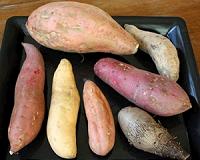 |
San Jose (AFP) Sept 20, 2010 Scientists from around the world gathered in Costa Rica this month to exchange ideas on ways to make sure orchids, among the world's most popular flowers, will still be around for the next generation to enjoy. Many of the orchids of the future, mere seeds today, are in a deep slumber inside glass vials in sub-zero temperature cared for by botanists with a group that has an acronym that sounds like a secret spy group: the OSSSU, or Orchid Seed Stores for Sustainable Use. Hugh Pritchard, a British scientist with the Millennium Seed Bank Project -- an international plant conservation project coordinated by the Britain's Royal Botanic Gardens, Kew -- said that the OSSSU hopes to build a network of seed banks around the world to preserve orchid seeds. The initial focus will be on the 250 species of the 35,000 orchid species in danger of extinction, Pritchard told AFP. "One of the factors is over-exploitation of species in the forests with commercial ends; another is climate change that is expected to accelerate the extinction of many species over the next 40 years," Pritchard said. Specialists from 23 countries belonging to the OSSU concluded a five-day meeting on the subject here on Friday. The project encourages scientists in each country to freeze large amounts of seeds of their native species at temperatures of -20 degrees Celsius (-4 degrees Fahrenheit). "The seeds will serve in the future for species re-introduction projects, habitat restoration and other sustainable uses," Pritchard said. Orchid seeds measure mere micrograms, so millions can be stored in vials in small freezer. "Theoretically, a representative sample of seeds from all of the world's orchid species could be stored in a space no larger than that occupied by a few domestic refrigerators," Pritchard wrote in an article with co-author Philip Seaton in the October 2008 edition of Orchids magazine. "Thus, seed banks can provide a means of preserving maximum genetic diversity in a minimum space, and at relatively little cost," the authors wrote. Ecuadoran biologist Eduardo Sanchez said that at the meeting, scientists from each country had their own ideas on the best ways to preserve their species. In Ecuador, for example, Cuenca University has decided to germinate 35,000 of the most marketable orchid species, then sell 10,000 of them at cut-rate prices to saturate the market and lower the demand. They will then plant the remaining 25,000 in forests near rivers, at botanical gardens and at the university itself to encourage both eco-tourism and an appreciation for the flower, Sanchez said. Tiiu Kull at the Estonian University of Life Sciences said there is a small number of orchid species in Estonia compared to the varieties found in tropical regions, but they are extremely rare and in danger of extinction. In the Philippines there are native orchid species that are on the verge of extinction because they are being used as base for the production of hybrids which are grown by the tens of millions for commercial use, said University of the Philippines - Los Banos professor Lilian Patena. Two earlier OSSSU workshops were held in China and Ecuador, both in 2007. The scientists also exchanged technical advice on how best to run seed banks.
Share This Article With Planet Earth
Related Links Farming Today - Suppliers and Technology
 Global Project Underway To Preserve Yam Biodiversity
Global Project Underway To Preserve Yam BiodiversityPorto-Novo1, Benin (SPX) Sep 21, 2010 Farmers and crop scientists worldwide are engaged in an ambitious new effort to add 3,000 yam samples to international genebanks with the aim of saving the diversity of a crop that is consumed by 60 million people on a daily basis in Africa alone, according to an announcement from the Global Crop Diversity Trust. In almost all the countries of the African yam belt, a large number of potent ... read more |
|
| The content herein, unless otherwise known to be public domain, are Copyright 1995-2010 - SpaceDaily. AFP and UPI Wire Stories are copyright Agence France-Presse and United Press International. ESA Portal Reports are copyright European Space Agency. All NASA sourced material is public domain. Additional copyrights may apply in whole or part to other bona fide parties. Advertising does not imply endorsement,agreement or approval of any opinions, statements or information provided by SpaceDaily on any Web page published or hosted by SpaceDaily. Privacy Statement |